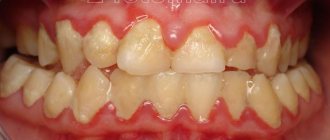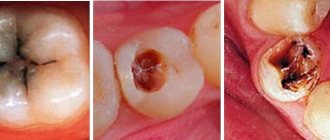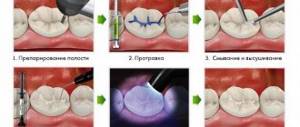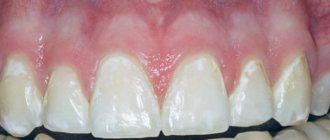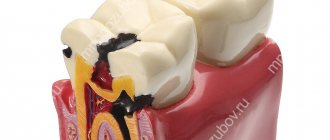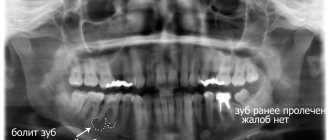Symptoms of caries
Diagnosis of the disease should only be carried out in the dentist's office. But the person himself can determine the presence of this pathology by very characteristic symptoms:
- the appearance of dark spots on the teeth: most often they appear on the chewing surface, but often inflammation develops between the teeth (but it is usually not possible for the patient to see this - special equipment will be required),
- there is a roughness of the surface of the teeth,
- When eating food, aching pain appears, teeth react to sweet and sour, as well as cold and hot. But the unpleasant sensations subside immediately as soon as contact with the irritant ceases - this is how caries, even deep ones, differs from pulpitis - inflammation of the dental nerve,
- Breath odor may become unpleasant,
- a carious cavity can even be felt with the tongue; food debris often gets clogged into it, which causes discomfort or even swelling of the tooth - for example, if a small gap appears under a filling.
From caries to pulpitis
Each of you has repeatedly heard about caries and pulpitis. These are interconnected diseases that arise from one another, in which irreversible destruction of the hard tissues of the tooth occurs. A problem detected in time can prevent more serious illnesses.
Prevention of caries - regular visits to the dentist.
Caries
Each of us has various microorganisms in our mouth. They secrete acid when they feed on leftover food. This acid destroys enamel. This is how caries begins. So, caries is damage to the enamel of teeth.
He shares:
- Caries in the spot stage.
An early form of caries, which manifests itself only as a slight discoloration. The patient will not experience pain. Here, gentle treatment is possible without excision of tooth tissue. With proper oral hygiene, the progression of the disease can be stopped.
- Superficial caries.
If the patient ignored the treatment of caries at the spot stage or simply did not notice it, the spot will begin to increase in diameter, forming a carious cavity. And here you can’t do without preparation.
- Average caries.
Over time, caries will penetrate deeper and deeper, and eventually begin to destroy dentin. Despite the fact that dentin is a hard tooth tissue, it is still softer than enamel. Therefore, here the carious cavity increases even more. Teeth can react to temperature (cold, hot) and chemical (sour, sweet) stimuli.
- Deep caries.
The stage of caries, during which a non-constant, sharp and aching pain will be felt. Unfortunately, many patients are willing to endure, delaying a visit to the dentist.
The main cause of pulpitis is ignored caries.
And when caries reaches the nerve, its inflammation occurs - this is pulpitis. The pain will be constant, and ordinary painkillers will not relieve it.
Pulpitis can be reversible and irreversible.
In certain cases, when caries is located at the border of the nerve and dentin, it is possible to leave the tooth “alive”. In this case, the doctor puts a special medicine on the site of the nerve communication. This is reversible pulpitis, in which the nerve will not be removed.
But if the destruction by caries has already reached the nerve, then the dentist will have to open the root canal and remove the nerve. This is irreversible pulpitis.
Caries and pulpitis in children
The processes and stages of the disease in children are practically no different from adults, except for one nuance - time. Since babies have not yet strengthened enamel, inflammatory processes occur rapidly. From caries in the spot stage to pulpitis, a few months are enough. The main thing is not to miss the onset of the disease, since inflammation of baby teeth can affect the rudiments of permanent teeth.
It is important to understand that timely visits to the dentist and regular professional teeth cleaning can prevent the development of the disease.
Published: 08/06/2020
Reasons for the development of the carious process
The development of caries largely depends on the individual characteristics of the body. For example, in women with hormonal imbalances, plaque accumulates on the teeth more often, which leads to an increased attack from bacteria. In general, caries is caused by pathological microorganisms, which become much more numerous in the oral cavity than good bacteria. And their appearance is caused by the following reasons:
- lack of proper hygiene: brushing your teeth for 20-30 seconds in the morning and evening is very little. Dentists' recommendations are at least 2 minutes twice a day, as well as removing food debris that accumulates in narrow spaces after eating. Gradually they transform into plaque, which is a provocateur of many dental diseases, including caries,
- poor nutrition: excessive consumption of sweet foods and changes in the PH composition of saliva - all this again contributes to the formation of plaque and an increased attack of bacteria,
- age: it has been established that the destructive processes of primary teeth actively develop in the first years of children’s lives. As you get older, the likelihood of developing dental diseases decreases. This is influenced by the fact that adults pay more attention to oral hygiene. In old age, the risk of caries increases again - this is the result of various diseases of the body and insufficient oral hygiene,
- pregnancy and lactation, that is, during those periods when a woman loses many vitamins and minerals, in particular calcium and fluoride,
- lack of vitamins and, as a result, increased fragility of tooth enamel,
- genetics: a predisposition to many diseases of the gums and teeth is passed on from parents.
Treatment of uncomplicated caries of the chewing tooth
Problem: a patient came to the Dial-Dent clinic for an appointment with a dentist-therapist for a preventive examination. The patient was not worried about anything, he just hadn’t been to the dentist for a long time and wanted to check the condition of his teeth.
Solution: The dentist recommends treatment of dental caries and subsequent restoration of the tooth with a light-curing filling.
Caries is the most common dental disease. Among children, caries ranks first among chronic infectious diseases. According to statistics, more than 80 percent of schoolchildren already have carious lesions. More than 95 percent of adults have had tooth decay treated and have their teeth filled. Let us remind you once again that caries in most cases occurs from uncontrolled consumption of sugary foods and drinks. Its appearance is also influenced by diet, poor diet, the properties of a person’s saliva, the amount of fluoride entering the body, as well as genetic factors. However, the main cause of caries is the remains of sweet foods, which become food for bacteria living in the oral cavity and secreting acids that destroy tooth enamel.
What is the insidiousness of caries? Often, only a small brown spot is visible on the surface; the tooth does not hurt, but when drilled out, a large carious cavity is revealed. This is explained by the different hardness of enamel and dentin. Pain in the tooth appears when caries has reached the nerve, then the tooth will be depulped.
The photo shows that on the surface the caries looks like a barely noticeable black stripe, and after drilling out the tooth, a large carious cavity is visible.
To prevent the tooth from getting sick again, it is necessary to completely remove the damaged tissue and evaluate the condition of the tooth - whether the inflammatory process has reached the nerve. The image shows that the cavity is deep, but the nerve is not affected.
The doctor cleaned the cavity to a clean, solid layer and carried out appropriate disinfecting procedures. Now you can proceed to filling the tooth. For the filling, a light-curing composite was used, the color of which was matched to the color of the tooth. A filling made from this material is reliable and aesthetically pleasing.
In this case, a filling was the optimal solution, but if the walls of the tooth are too thin or partially destroyed, then such a tooth must be restored with a crown - this is a more reliable method that provides a greater guarantee. You can also use a ceramic dental inlay to restore a badly damaged tooth.
A few simple tips for those who want to keep their teeth healthy: visit your dentist regularly for preventive examinations, have your teeth professionally cleaned annually to remove soft plaque and tartar, with the help of a hygienist, select the oral hygiene products that suit you, and do not be lazy in brushing your teeth. in the morning and in the evening.
The cost of caries treatment at Dial-Dent consists of the following components of treatment:
- Sight x-ray (1-2 teeth) - 390 rubles.
- Anesthesia (Ubistesin forte, Germany) - 390 rubles.
- Filling made of light-curing composite (Spectrum, Direct, Esthet-X) Germany - 5500 rub.
Other works by doctors at the Dial-Dent clinic.
Make an appointment for a consultation by phone +7-499-110-18-04 or through the form on the website. You can ask questions about dental treatment with a microscope to the chief doctor of the clinic, Sergei Vladimirovich Tsukor, at
Treatment methods
Cure caries, especially at the initial stage, is not difficult - this involves removing the inflamed tissue and then filling it. In the presence of deep lesions, binoculars and a microscope can be used, which allow you to increase the working space and remove even the smallest inflamed cells, while preserving healthy tissue. Depending on the situation, it may also be necessary to restore the coronal part if it has been severely damaged.
Fissure sealing A method that allows you to stop the carious process. Essentially, this is the prevention of inflammation. Fissures or depressions (grooves) on the surface of the enamel are filled with a special sealant, which evens them out and thereby prevents the accumulation of bacteria and plaque.
Price:
from 2500 rubles more details about the solution
Treatment of caries If the doctor notes caries at the spot stage, then the main procedure is remineralization (restoration of the required mineral content) using a special solution. If the caries is superficial, medium or deep, then the resulting cavity will need to be treated, followed by filling using composite materials. When the carious process penetrates into the deep layers, it is advisable to use medicated pads containing calcium hydroxide - this way additional protection is created to preserve the dental nerve.
Price:
3000 rubles more details about the solution
Installing an inlay In a number of situations, when the tooth is quite badly damaged and a large filling will not hold, you can develop an individual inlay made of ceramic or zirconium dioxide. It will accurately follow all the curves of the tooth and be securely fixed inside the cavity. At the same time, it will last many times longer than a large filling.
Price:
from 20,000 rubles more about the solution
Symptoms of hidden caries
Hidden caries does not manifest itself with any symptoms, until the deepest tissues of the tooth are affected. In the initial stages, when the disease develops within the enamel, chalky and yellowish spots are practically not visualized, as is the case with ordinary caries.
With the development of pathology, destruction processes reach the dentin, and then penetrate into the pulp. If a nerve is affected, then painful sensations almost inevitably begin to manifest themselves. Pain often appears when exposed to thermal irritants, as well as foods with a strong taste (sweet, sour or salty). The pain sensations at first cannot be called sharp, but over time they intensify and bring even the most patient patient to the dental office. Unfortunately, by this time, removal of the nerve and filling of the canals is most often required.
Types of deep caries
Dentists divide caries into several types depending on the degree of neglect, namely chronic and acute. These varieties differ not only in the degree of tissue damage, but also in the methods of treatment.
- Acute deep caries. The process of destruction of hard tissues in the event of the appearance of this disease is quite rapid. It is characterized by a deep cavity that overhangs the enamel. The enamel becomes loose, changes color and acquires a light disintegration.
- Chronic caries. This type is characterized by the fact that its development is much slower than acute, since before the tooth begins to get sick, there is a depletion of minerals that help resist the disease. During the onset of a chronic form, dentin increases, and irritation of the pulp decreases; in addition, secondary dentin begins to form, which prevents the nerve from becoming inflamed.
Main symptoms of caries
One of the main signs is the rare occurrence of pain, which is influenced by:
- Cold air and chilled water are thermal irritants.
- Sweet, salty and sour foods are chemical irritants.
As soon as the teeth stop touching the above factors, the unpleasant sensations disappear. If pain appears without the presence of irritants, this means that caries has entered the “Pulpitis” stage.
Deep caries is most often detected during a meal, when a person chews food - its particles fall on the carious area and press on the bottom. In this case, it is necessary to completely remove food particles from the carious area so that the pain disappears.
Let's look at the key differences between pulpitis and caries:
- With caries, pain can only appear in the presence of irritants (remove the irritant, the pain disappears).
- With pulpitis, pain can appear even when there are no irritants (pain with pulpitis is typically acute).
- Chronic pulpitis, like caries, causes pain as a result of exposure to external and internal irritants. The difference between caries and chronic pulpitis is that when the irritants stop, the pain will last for another 10 to 15 minutes.
Methods for determining dental caries at home
- The pains described above.
- The cavity may be very sharp or uneven and can be felt with the tongue.
- Constant bad breath will also indicate the presence of caries. After eating, food particles remain in the carious area, which are very difficult to get out. Over time, food begins to rot and creates an unpleasant odor.
- Tooth decay can be easily seen when looking in the mirror. Darkening of the dental tissue indicates a problem.

